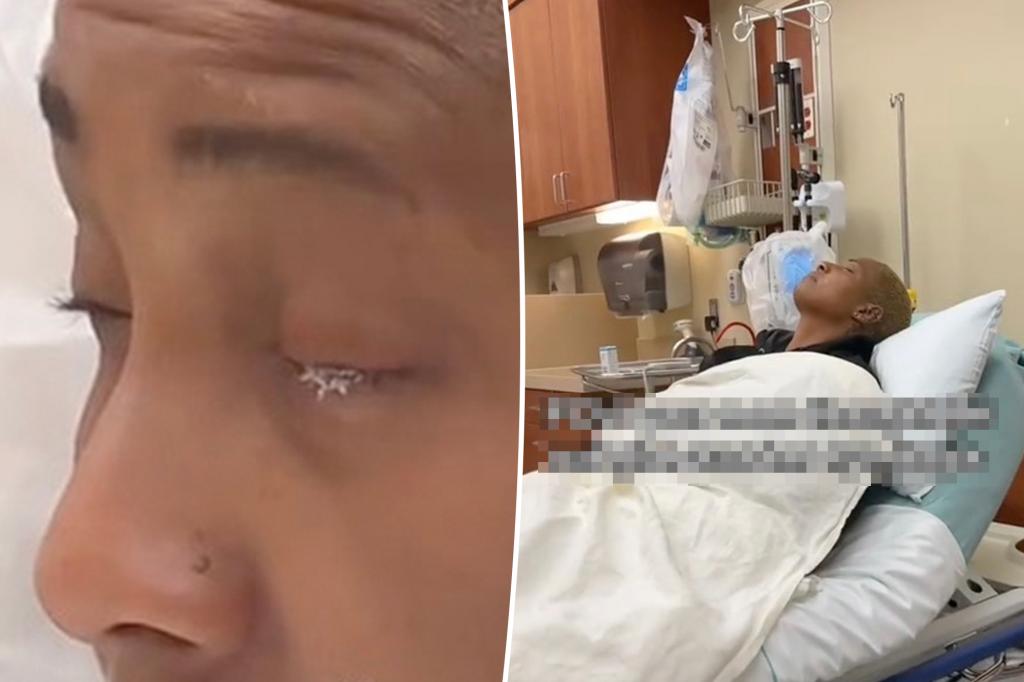This incident highlights a surprisingly common yet alarming household mishap: mistaking nail glue for eye drops. The consequences, as vividly illustrated by the experience of a North Carolina woman, can be severe and long-lasting. The woman, whose ordeal was captured on video by her daughter and subsequently shared on social media, accidentally sealed her eye shut with nail glue, facing a potential two-month wait before she can open it again. The incident sparked a wave of sympathy and concern online, with many users sharing similar experiences or expressing their astonishment at the ease with which such a mistake can occur. The incident underscores the urgent need for clearer differentiation between these two products, often packaged in similar small bottles.
The viral video, depicting the woman lying in a hospital bed with her eye covered in white glue residue, quickly gained traction across various social media platforms. The footage evoked strong reactions, ranging from empathy and concern to calls for changes in product packaging. Many commenters expressed disbelief and sympathy for the woman’s plight, sharing their own near misses or similar experiences with nail glue accidents. The incident resonated with a surprisingly large number of people who admitted to having either personally experienced or witnessed similar mishaps. This widespread relatability propelled the video to viral status, turning it into a cautionary tale about the potential hazards lurking in everyday household items.
Beyond the immediate shock and sympathy, the online conversation quickly shifted to the underlying issue of confusing product packaging. Numerous commenters pointed out the striking resemblance between nail glue and eye drop bottles, both typically small and dispensed through a nozzle. This similarity, they argued, increases the risk of accidental misuse, especially in dimly lit or rushed situations. The incident fueled calls for manufacturers to redesign nail glue packaging to make it distinctly different from eye drops, potentially preventing similar accidents in the future. Suggestions included altering the shape, size, color, or labeling of nail glue bottles to eliminate any resemblance to eye drop containers.
The woman’s daughter, Ria Faggart, utilized the unexpected virality of the video to launch a GoFundMe campaign for her mother. Recognizing the financial strain that the accident would impose, Ria sought to alleviate the burden of medical expenses and lost income. Her mother, a foster parent, faced an extended period of time off from work without disability benefits, making financial assistance crucial for her recovery and ongoing care. The GoFundMe page provided a platform for Ria to share her mother’s story, emphasizing her role as a foster parent and the unexpected hardship caused by the accident.
The GoFundMe appeal detailed the extent of the woman’s injuries and the anticipated recovery timeline. According to doctors, the woman would likely have to wait five to seven weeks for her eye to open, after which further examinations would be necessary to assess the extent of the damage. This prolonged period of recovery meant a significant loss of income, compounding the financial challenges faced by the family. The GoFundMe page highlighted the urgency of the situation and the importance of community support in helping the woman navigate this difficult period.
The incident serves as a stark reminder of the potential dangers of seemingly innocuous household products and the importance of careful labeling and storage. The widespread online reaction to the woman’s ordeal underscored the need for increased awareness of such risks and the importance of preventative measures. The incident also highlighted the power of social media in both spreading awareness and mobilizing support for those in need. While the woman’s road to recovery is likely to be long and challenging, the outpouring of support from online communities offers a glimmer of hope and a testament to the power of human compassion. The incident, though unfortunate, has sparked a crucial conversation about product safety and the need for clearer differentiation between potentially hazardous household items.










